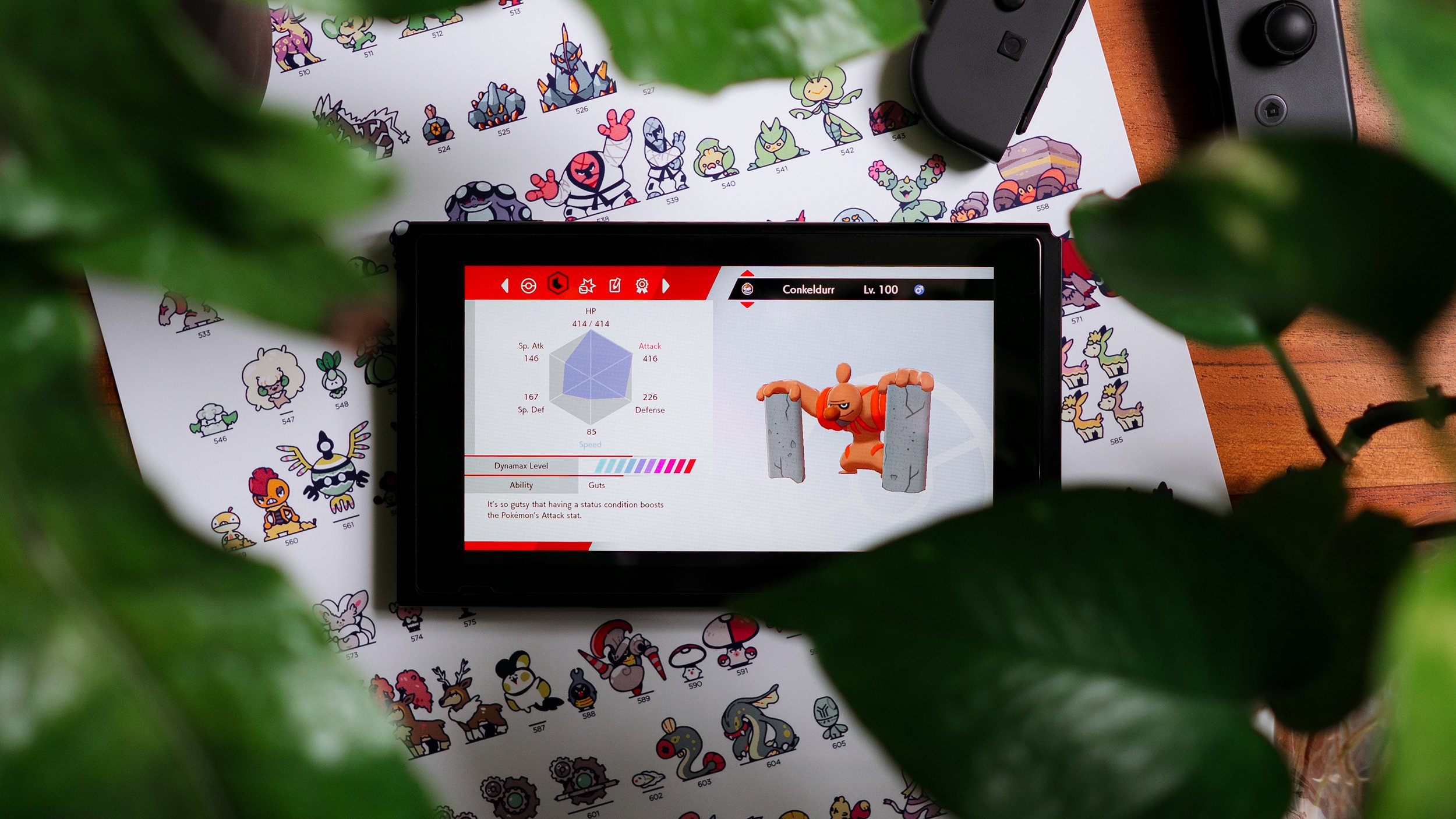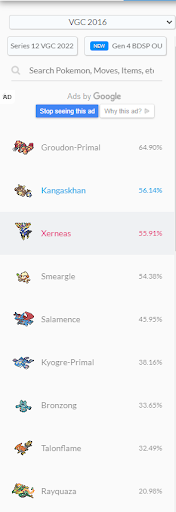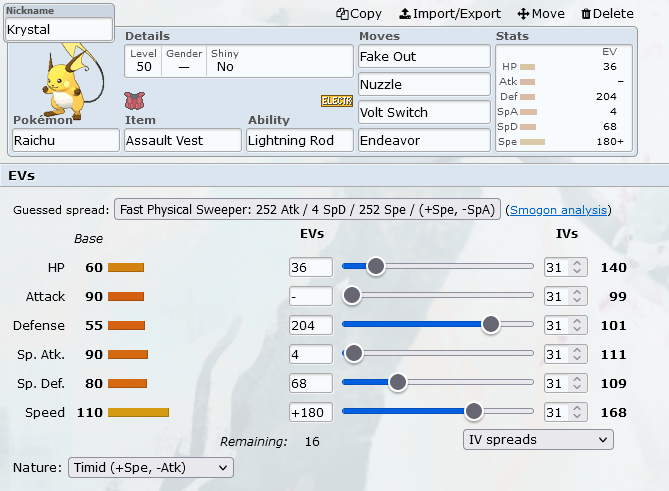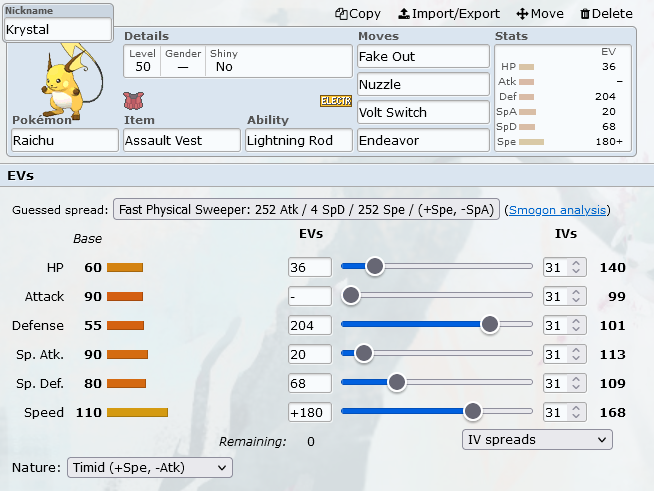
EVing #3: How to make a complex EV spread
7min 56sec read
A guide to advanced EV spreads.
Written by Wolfe Glick
Teambuilding / Putting It All Together
So you’ve decided you do want a complex EV spread, and you want to know how to get started. The following is my personal process - I’m sure most people who make complex EV spreads do it in their own way, so if this doesn’t work for you, feel free to experiment to find a better fit.
When I begin working on a team, I almost always give all of my Pokémon either a simple EV spread or a recycled EV spread from a previous team. I don’t begin with a complex spread, because EV spreads are strongest within the context of your team, so it’s important when you use a complex spread that it is tailored to your specific team. Until you know what your team needs, it’s better to use a simple spread or a spread you’re comfortable with from the past. I suggest gradually adjusting a complex spread over time based on how your practice games are going. When you do want a complex spread, the process below can help guide you.
Step 1: No Compromises
The very first step in deciding on a complex EV spread is to consider the aspects of your Pokémon that you are absolutely not willing to compromise on. For an offensive Pokémon, this is probably their Speed and offensive Stat - for example, let's say you want your Assault Vest Kartana to always outspeed Nihilego, so you aren’t willing to go below 212 Speed EVS (Jolly), and to always 2HKO opposing Focus Sash Kartana after Intimidate which requires 132 EVs. Great! That means you have 164 EVs leftover to make the rest of your EV spread.
For a defensive Pokémon, this is typically what attacks you always want to survive no matter what. You’re going to want to know how to use a damage calculator. Say you want your Dusclops to always survive Black Glasses Jolly Urshifu-Single-Strike Wicked Blow. There’s a few ways to do this, but it will typically involve max HP and a Defense-boosting nature.
This step probably seems simple, but it’s the one that trips people up the most. With EVs, it’s very easy to get caught up in what you CAN do - it’s much harder to know what you SHOULD do with your Pokémon instead.
Learning to identify what a Pokémon needs to succeed is one of the most important skills to develop. This step becomes much easier when you have a good understanding of the metagame. Try to think about which popular Pokémon you are realistically going to go up against, and which of them are important to knock out or survive attacks from.
Step 2: Pick a Speed
Once you’ve identified what you want your Pokémon to do, your next step is to decide on the Pokémon’s Speed stat. Speed is one of the most important parts of a Pokémon battle, and being naturally faster than your opponent can give you a big advantage. There isn’t one right way to know what Speed your Pokémon should be, but there are a few things you can consider.
Are there Pokémon that you want your Pokémon to outspeed for sure?
Do you want to be faster than other Pokémon of the same species or Speed tier?
How many EVs do you need to invest in order to achieve the above two goals?
Just as in the above example, this is mostly dependent on the rest of the metagame. Think about how much of an impact it will make if you are faster than popular Pokémon. It might not matter if you outspeed an opponent's Pokémon if you can’t do anything to it, or if you just want to switch your Pokémon out a majority of the time. If you aren’t sure what Pokémon you want to outspeed, start with a simple EV spread and pay attention to which Pokémon you find yourself going up against often in your games.
Step 3: Round out your Spread
If you’ve followed this process, you should have a Speed stat and a few benchmarks for your EV spread. Now it’s time to figure out what you want to do with the rest of your spread. Just like the previous step, consider what scenarios your Pokémon is likely to be in, and if there are things you can do with your spread that can help it shine. Don’t get too lost in the weeds here - pay attention to what actually happens when you use your Pokémon in battle.
To me, this step normally happens when I’m in a practice match and something unexpected happens. It’ll normally follow me getting KOed by something I expected to survive, or failing to KO something I thought was in range. I’ll open up my damage calculator and see how much investment it would take to reverse the scenario that surprised me.
EVs in Pokémon have an opportunity cost. Every point you put into one stat is a point you could have put somewhere else. Sometimes you might find that you could survive an attack or pick up a KO or outspeed a threat, but it would take significant investment. Consider if the scenario you’re EVing for is worth losing the value those stat points could do somewhere else.
The Big Picture
When making an EV spread, make sure you consider what matchups you’re actually bringing your Pokémon to! Making a specific spread to counter an opposing Pokémon is great, but not useful if you can’t bring your Pokémon to the battle.
General Notes on EV Spreads
You get the most value (stat wise) out of your nature when it raises your highest stat after EVs. If your nature isn’t helping you do anything specific, have it raise your highest stat.
There are diminishing marginal returns to stat points. Investing 20 points into your Kartana’s Attack stat will change your damage calcs a lot less than investing 20 points into its Special Defense. The reason for this is because you’re changing the proportion less. If Kartana uses 68 EVs in Attack, its stat goes from 201 to 210, which is about a 1% increase. Those same 68 EVs in Special Defense take it from 51 to 60, which is about a 17% increase. Even though in both cases our stat went up by 9 points, those points had a bigger impact in Special Defense because it was a larger change relative to the starting point.
Some things in Pokémon use a percent of your HP stat, like Life Orb (10% recoil), Grassy Terrain (1/16 recovery per turn) and Sandstorm (1/16 damage per turn). If you utilize these effects, you can optimize your HP values by minimizing recoil damage or maximizing healing. Life Orb prefers the last digit of your HP stat to be high (169 HP takes 16 damage from Life Orb, 170 takes 17), and Grassy Terrain likes your HP to be above a multiple of 16 when close while Sandstorm you want to be lower (160 HP takes 10 damage from sandstorm, while 159 takes 9).
To my knowledge, a neutral nature (a nature that raises no stats while lowering no stats) should never be mathematically optimal.
You always want to invest in an odd number of stats with your EVs. All EVs should be multiples of 4 + 8x (4, 12, 20, …, 244, 252). If you invest in an even number of stats or do not use the above multiples, you will be wasting stat points at level 50.
Not every stat change will change a damage calculation - if you’re EV’ing to survive something specific, make sure that lowering the relevant stats make a difference in the damage calculator.
The first 4 EVs in any given stat give you a stat point, and after that you need 8 EVs to get a point. For this reason, many players prefer to use spreads that are 252/244/4/4/4 instead of 252/252/4, as your Pokémon will have one additional stat point in the former case (you should almost never run 244 speed, don’t take your 8 EVs from that stat).
“Be careful of overengineering EV spreads that can be thrown off by a tiny bit of damage. For example, if you survive an attack with 94-99% of your health remaining, some damage from Sandstorm or Fake Out will mean that you no longer survive that attack. That can still be okay– you just have to keep that in mind when you’re battling.”
Example: 2016 Worlds Raichu
For Worlds 2016, I knew I needed a complex EV spread for my Raichu. This is the Raichu in question, without EVs. Let’s go through our process using this Raichu as an example.
Step 1: Example
I needed to decide what the benchmarks were of my Raichu that I was not willing to compromise on. To start, the easiest thing was to pick a Speed stat. Raichu (as a species) can only be between 130 Speed (31 IVs, 0 EVs and a neutral nature) and 178 Speed(252 EVs and a Speed boosting nature). I knew that the absolute slowest I could afford to go was 168 stat, which is exactly one above Pokémon with a Base Speed stat of 100. The reason I chose to outspeed this specific number was due to the prevalence of Mega Kangaskhan, a Pokémon with 100 Base Speed. I have narrowed down that I want my Raichu to be between 168 and 178 Speed Stat. My Raichu’s moveset was Fake Out, Nuzzle, Volt Switch, and Endeavor. This was a very supportive moveset, but it could still be threatening if Raichu was able to use Endeavor after surviving a big hit to bring the target’s HP very low. I hoped to allow Raichu to survive Kyogre Origin Pulse and Kangaskhan Double Edge after Intimidate, with stretch goals of Xerneas Boosted Moonblast and Groudon Precipice Blades after Intimidate if possible.
Step 2: Example
This step is simple here - I’d narrowed down that I wanted to be between 168 and 178 Speed. After looking at the additional Pokémon I would outspeed by investing more points, I realized that the list was relatively short - Raichu already has priority due to Fake Out, and the few Pokémon I missed out on by not investing 252 points in Speed were not especially relevant for the metagame. I decided to start with 168 Speed, and adjust it if I ran into problems during testing.
Step 3: Example
So far, our Raichu looks like this:
We have 328 EVs left to play with, and no nature. Additionally, we have some benchmarks in mind. Let’s start with Kangaskhan. First, how much does Kangaskhan do with our current spread?
252 Atk Parental Bond Kangaskhan-Mega Double-Edge vs. 0 HP / 0 Def Raichu: 239-283 (177 - 209.6%) -- guaranteed OHKO
Okay, so we definitely can’t survive that attack. What if Mega Kangaskhan has been Intimidated?
-1 252 Atk Parental Bond Kangaskhan-Mega Double-Edge vs. 0 HP / 0 Def Raichu: 160-190 (118.5 - 140.7%) -- guaranteed OHKO
Still not great. Next, let’s see what happens if we maximize our Defense.
-1 252 Atk Parental Bond Kangaskhan-Mega Double-Edge vs. 0 HP / 252 Def Raichu: 113-135 (83.7 - 100%) -- 0.4% chance to OHKO
This shows us that it is possible, but it’s going to take a lot of Defense investment and some HP as well. We’re going to stick a pin in this to take a look at some special attacks we’ll be taking, to help us figure out how much investment we have left over.
Kyogre’s Origin Pulse is a very important move for this Raichu to survive, given the context of this team. Let’s see how Raichu currently stacks up against it.
252+ SpA Kyogre-Primal Origin Pulse vs. 0 HP / 0 SpD Assault Vest Raichu in Rain: 118-141 (87.4 - 104.4%) -- 31.3% chance to OHKO
Excellent - clearly we’re pretty close to being able to survive Kyogre Origin Pulse, and can do it with just a little Special Defense and HP. The shape of our spread is starting to take place - we can infer that our Raichu will likely have a lot of investment in Defense, and a little in Special Defense and HP. Let’s see how Raichu handles Xerneas next.
+2 252 SpA Fairy Aura Xerneas Moonblast vs. 0 HP / 0 SpD Assault Vest Raichu: 174-205 (128.8 - 151.8%) -- guaranteed OHKO
+2 252 SpA Fairy Aura Xerneas Dazzling Gleam vs. 0 HP / 0 SpD Assault Vest Raichu: 109-129 (80.7 - 95.5%) -- guaranteed 2HKO
With this, we can see we’re already surviving Dazzling Gleam and never surviving Moonblast without significant investment. Raichu wasn’t even supposed to come to most Xerneas matchups, so we’re not going to consider EV’ing for Xerneas having seen these calcs.
Right before the World Championships, Timid Special Groudon picked up in popularity. Let’s see how strong it is compared to Origin Pulse.
252 SpA Groudon-Primal Eruption (150 BP) vs. 0 HP / 0 SpD Assault Vest Raichu in Harsh Sunshine: 127-150 (94 - 111.1%) -- 68.8% chance to OHKO
252 SpA Groudon-Primal Earth Power vs. 0 HP / 0 SpD Assault Vest Raichu: 138-164 (102.2 - 121.4%) -- guaranteed OHKO
So, Eruption is a bit stronger than Kyogre’s Origin Pulse, but still within range where we can probably survive it without too much investment.
Now we’re ready to actually start filling in some numbers. Let’s try and see what it would take to survive Kangaskhan’s Double Edge after Intimidate.
-1 252 Atk Parental Bond Kangaskhan-Mega Double-Edge vs. 4 HP / 252 Def Raichu: 113-135 (83 - 99.2%) -- approx. 2HKO
Great! We survive! But did we survive in a way that is efficient? Doing it this way takes 256 EV’s - what if we can do it with less? The less EV’s we use here, the more EV’s we have to use elsewhere. And even if this is the least amount of EVs possible, we might be able to redistribute them to get a bit more HP which could aid in our special calculations. In this case, we can see immediately that what we were doing was not optimal:
-1 252 Atk Parental Bond Kangaskhan-Mega Double-Edge vs. 12 HP / 228 Def Raichu: 113-136 (82.4 - 99.2%) -- approx. 2HKO
This also always survives Kangaskhan Double Edge, but only uses 240 EVs - meaning we now have 16 EVs to use elsewhere! If you’re wondering how I knew to use these numbers, I simply lowered my Defense stat one point at a time and raised my HP stat a corresponding amount. Remember, not every point you put into a stat will change the damage calcs - in this case, 244 Defense and 252 Defense give the same damage roll, as do 228 and 236 Defense EVs.
Let’s continue this process, lowering Defense and raising HP to still survive:
-1 252 Atk Parental Bond Kangaskhan-Mega Double-Edge vs. 12 HP / 220 Def Raichu: 117-139 (85.4 - 101.4%) -- 2% chance to OHKO (232 EVs used)
-1 252 Atk Parental Bond Kangaskhan-Mega Double-Edge vs. 12 HP / 204 Def Raichu: 118-140 (86.1 - 102.1%) -- 5.1% chance to OHKO
-1 252 Atk Parental Bond Kangaskhan-Mega Double-Edge vs. 36 HP / 204 Def Raichu: 118-140 (84.2 - 100%) -- 0.4% chance to OHKO (240 EVs used)
-1 252 Atk Parental Bond Kangaskhan-Mega Double-Edge vs. 36 HP / 188 Def Raichu: 121-144 (86.4 - 102.8%) -- 5.1% chance to OHKO
-1 252 Atk Parental Bond Kangaskhan-Mega Double-Edge vs. 60 HP / 188 Def Raichu: 121-144 (84.6 - 100.6%) -- 0.4% chance to OHKO (248 EVs used)
We want to minimize our odds of getting KO’d, so we’re only considering options 1, 3, and 5 above. Although the first option uses the least amount of EV’s, we’re going to use option 3 because it allows us 3 more HP points than the first at the cost of only 8 additional EVs, and it is cheaper than the 5th EV spread. This Raichu is a special case in that we want to keep its HP as low as possible beyond surviving calcs, because Endeavor is stronger the lower the user's HP.
Our Raichu now looks like this:
With 88 EVs left to play with, let’s revisit our Groudon and Kyogre damage calculations again.
252+ SpA Kyogre-Primal Origin Pulse vs. 36 HP / 0 SpD Assault Vest Raichu in Heavy Rain: 118-141 (84.2 - 100.7%) -- 6.3% chance to OHKO
252 SpA Groudon-Primal Eruption (150 BP) vs. 36 HP / 0 SpD Assault Vest Raichu in Harsh Sunshine: 127-150 (90.7 - 107.1%) -- 43.8% chance to OHKO
Now that we have an HP stat in mind, we can easily find out how much Special Defense we need.
252 SpA Groudon-Primal Eruption (150 BP) vs. 36 HP / 20 SpD Assault Vest Raichu in Harsh Sunshine: 126-148 (90 - 105.7%) -- 37.5% chance to OHKO
252 SpA Groudon-Primal Eruption (150 BP) vs. 36 HP / 28 SpD Assault Vest Raichu in Harsh Sunshine: 123-145 (87.8 - 103.5%) -- 25% chance to OHKO
252 SpA Groudon-Primal Eruption (150 BP) vs. 36 HP / 36 SpD Assault Vest Raichu in Harsh Sunshine: 121-144 (86.4 - 102.8%) -- 18.8% chance to OHKO
252 SpA Groudon-Primal Eruption (150 BP) vs. 36 HP / 60 SpD Assault Vest Raichu in Harsh Sunshine: 118-141 (84.2 - 100.7%) -- 6.3% chance to OHKO
252 SpA Groudon-Primal Eruption (150 BP) vs. 36 HP / 68 SpD Assault Vest Raichu in Harsh Sunshine: 118-139 (84.2 - 99.2%) -- guaranteed 2HKO
Either of the last two options would be acceptable - I personally chose to go with the last one for extra security. And just to be complete, here’s how Raichu stacks up against Kyogre:
252+ SpA Kyogre-Primal Origin Pulse vs. 36 HP / 68 SpD Assault Vest Raichu in Heavy Rain: 109-130 (77.8 - 92.8%) -- guaranteed 2HKO
Note: Although in this example we go from one calculation to another without backtracking, in practice you’re very often trying to find the balance between HP, Defense, and Special Defense fluidly depending on what you’re trying to survive. For the purpose of this example, I thought it was clearer to do them consecutively - in reality, making and tweaking a spread nearly always requires lots of adjusting and backtracking.
Here’s what our Raichu looks like now:
Remember, we always invest in an odd number of stats, so our Raichu ACTUALLY looks like this:
We only have 16 EVs left to play with. At this point, we’ve accomplished what we set out to do with our spread, and these 16 EVs are most likely not going to make a huge impact. You can do a few things with them, however:
Invest in Speed, to outspeed other Pokémon that had the same goal with their speed stat as yours
Increase the odds on a more specific calc or work towards a stretch goal
Put into HP for general bulk
Invest in offense for specific calcs
I personally opted to go with option 4, as it gave me higher odds of breaking Mega Gengar's Substitute which could be very problematic for my team. Here’s my final spread:
However, the following spreads would also all be just as good and have specific strengths:
Higher Speed EVs
Higher Sp. Def EVs
Higher Defense EVs
For the full list of what I calc’ed going into Worlds 2016, check out this document I made and memorized before the event.
Wrapping Up
At the end of the day, the specific spread you settle on should reflect what you expect to play against and what you want to cover for. EV’ing, just like many other aspects of Pokémon, is a skill - you need to do it in order to get better. When I first started out, I was awful at making EV spreads and always needed friends to help me. Keep practicing, don’t get discouraged, and don’t forget the fundamentals - the more experience you get with it, the easier it becomes.








